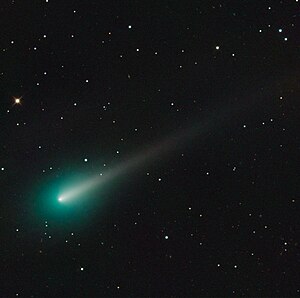C / 2012 S1 (ISON)
| C / 2012 S1 (ISON) [i] | |
|---|---|

|
|
|
ISON on October 8, 2013, image taken at Mount Lemmon Observatory
|
|
| Properties of the orbit ( animation ) | |
| Orbit type | hyperbolic |
| Numerical eccentricity | 1,00020 |
| Perihelion | 0.012 AU |
| Inclination of the orbit plane | 62.4 ° |
| Perihelion | November 28, 2013 |
| Orbital velocity in the perihelion | 377 km / s |
| history | |
| Explorer | Vitaly Nevsky, Artyom Novichonok, ISON |
| Date of discovery | September 21, 2012 |
| Source: Unless otherwise stated, the data comes from JPL Small-Body Database Browser . Please also note the note on comet articles . | |
C / 2012 S1 (ISON) was a comet that probably came from the Oort Cloud and came very close to the Sun on November 28, 2013 . Because of this close proximity, he was one of the so-called sun streaks , but was not a member of the Kreutz group .
discovery
The comet was discovered on September 21, 2012 by amateur astronomers Vitali Nevski (Виталий Невский) from Belarus and Artyom Novitschonok (Артём Новичонок) from Russia on CCD images that they made with a 40-centimeter telescope of the International Scientific Optical Network (ISON) won when discovered as a faint nebula in the constellation Cancer . The comet was named after this organization.
Trajectory
On October 1, 2013, it approached Mars to within 10.9 million kilometers. The comet then reached its closest point to the Sun on November 28, 2013. In the perihelion - ISON had an orbital speed of around 360 km / s - its distance to the sun was only around 0.012 AU (1.8 million kilometers), which corresponds to about the diameter of the sun. The temperature on the surface of the comet's nucleus was possibly over 2500 ° C. After a strong loss of brightness, it was assumed that the comet had broken during its passage through the sun because of the high temperature and the strong tidal forces ( Roche limit ). Even if images from the SOHO space probe were interpreted in such a way that at least part of the comet had survived the perihelion, from December 2, 2013, the conviction grew that the former comet was now moving through the solar system as a dust cloud. Last images from the Hubble Space Telescope on December 18, 2013 showed no remains of the comet. The coordinates to the presumed whereabouts were calculated from the last positions at which ISON was still visible. Objects up to 25th magnitude could have been shown in the recordings, which would correspond to rubble with a diameter of about 160 meters or more. Since the pictures show no traces of ISON , it can be assumed that only gas, dust and the smallest debris are left.
The closest approach to Earth was calculated for ISON - or its remains - for the night of December 26th to 27th, 2013 at a distance of about 60 million kilometers.
visibility
The Max Planck Institute for Solar System Research announced on November 18, 2013 that it was visible to the naked eye from Earth. At first it was assumed that in the vicinity of the sun it could even briefly reach full moon brightness (−12.7 mag ). In fact, the brightness in the perihelion remained far below.
research results
In February 2013 the observation of the comet ISON started as part of the follow-up mission EPOXI of the space probe Deep Impact . Due to the course of the orbit, the observation of the comet lasted about a month, which gave the researchers extensive images for analysis. The Mars Reconnaissance Orbiter and Lunar Reconnaissance Orbiter probes were also used.
Web links
- Current reporting on comet ISON, pictures and location cards on the pages of Bayerischer Rundfunk
- C / 2012 S1 (ISON) - The next big comet? on scilogs.de
English language articles and websites:
- ISON on nasa.gov
- NASA Comet ISON Observing Campaign: light curve, news, blogs
- spaceweather.com: big sun-diving comet discovered
- New Comet: C / 2012 S1 (ISON)
Individual evidence
- ↑ Tail stars: Space probe Deep Impact observes comet ISON from Tilmann Althaus, ASTROnews on sterne-und-weltraum.de from February 7, 2013
- ↑ marspages.eu Off Topic: News from Comet ISON
- ↑ spaceweather.com , Nov. 23, 2013
- ↑ wetteronline: Comet ISON largely broken. Only a few remains intact
- ↑ Comet ISON May Have Survived nasa.gov (English) online on the Internet: November 29, 2013
- ↑ Florian Freistetter : After perihelion: is ISON now colliding with the earth? , Science Blogs, December 2, 2013.
- ↑ hubblesite.org by Zolt Levay, December 20, 2013
- ↑ Comet "Ison": tail star can be seen with the naked eye , Focus online from November 18, 2013
- ↑ www.planetarium-hamburg.de: Is ISON falling apart? , accessed December 3, 2013
- ↑ www.icq.eps.harvard.edu: Recent Comet Brightness Estimates , accessed December 3, 2013
- ↑ Deep Impact Images Spectacular incoming Comet ISON - Curiosity & NASA Armada Will Try by Ken Kremer on February 6, 2013


